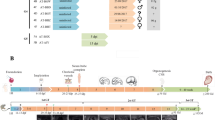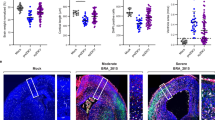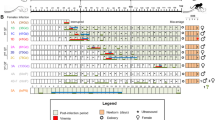Abstract
We describe the development of fetal brain lesions after Zika virus (ZIKV) inoculation in a pregnant pigtail macaque. Periventricular lesions developed within 10 d and evolved asymmetrically in the occipital–parietal lobes. Fetal autopsy revealed ZIKV in the brain and significant cerebral white matter hypoplasia, periventricular white matter gliosis, and axonal and ependymal injury. Our observation of ZIKV-associated fetal brain lesions in a nonhuman primate provides a model for therapeutic evaluation.
This is a preview of subscription content, access via your institution
Access options
Subscribe to this journal
Receive 12 print issues and online access
$259.00 per year
only $21.58 per issue
Buy this article
- Purchase on SpringerLink
- Instant access to full article PDF
Prices may be subject to local taxes which are calculated during checkout


Similar content being viewed by others
References
Petersen, L.R., Jamieson, D.J., Powers, A.M. & Honein, M.A. N. Engl. J. Med. 374, 1552–1563 (2016).
Miner, J.J. et al. Cell 165, 1081–1091 (2016).
Cugola, F.R. et al. Nature 534, 267–271 (2016).
Wu, K.Y. et al. Cell Res. 26, 645–654 (2016).
Rasmussen, S.A., Jamieson, D.J., Honein, M.A. & Petersen, L.R. N. Engl. J. Med. 374, 1981–1987 (2016).
Conrad, S., Ha, J., Lohr, C. & Sackett, G. Am. J. Primatol. 36, 15–35 (1995).
Haddad, J. et al. Neuropediatrics 21, 215–217 (1990).
Leonard, J.R. et al. AJR Am. J. Roentgenol. 174, 1651–1655 (2000).
Brasil, P. et al. N. Engl. J. Med. http://dx.doi.org/10.1056/NEJMoa1602412 (2016).
Driggers, R.W. et al. N. Engl. J. Med. 374, 2142–2151 (2016).
Dudley, D.M. et al. Nat. Commun. 7, 12204 (2016).
Styer, L.M. et al. PLoS Pathog. 3, 1262–1270 (2007).
Li, M.I., Wong, P.S., Ng, L.C. & Tan, C.H. PLoS Negl. Trop. Dis. 6, e1792 (2012).
Lennartsson, F., Nilsson, M., Flodmark, O. & Jacobson, L. Invest. Ophthalmol. Vis. Sci. 55, 8278–8288 (2014).
Adams Waldorf, K.M., Rubens, C.E. & Gravett, M.G. BJOG 118, 136–144 (2011).
Bruce, A.G. et al. J. Virol. 87, 13676–13693 (2013).
Nakgoi, K. et al. Am. J. Primatol. 76, 97–102 (2014).
Putaporntip, C. et al. Mol. Ecol. 19, 3466–3476 (2010).
Sourisseau, M. et al. Gastroenterology 145, 966–969.e7 (2013).
National Research Council. Guide for the Care and Use of Laboratory Animals 8th edn. (The National Academies Press, 2011).
Weatherall, D. The use of nonhuman primates in research. (Academy of Medical Sciences, Medical Research Council, The Royal Society and Wellcome Trust, 2006).
Woods, S.E., Marini, R.P. & Patterson, M.M. J. Am. Assoc. Lab. Anim. Sci. 52, 295–300 (2013).
Kim, K. et al. IEEE Trans. Med. Imaging 29, 146–158 (2010).
Kim, K. et al. IEEE Trans. Med. Imaging 30, 1704–1712 (2011).
Fogtmann, M. et al. IEEE Trans. Med. Imaging 33, 272–289 (2014).
Bazin, P.L. & Pham, D.L. Comput. Methods Programs Biomed. 88, 182–190 (2007).
Provencher, S.W. NMR Biomed. 14, 260–264 (2001).
Lanciotti, R.S. et al. Emerg. Infect. Dis. 14, 1232–1239 (2008).
Keller, B.C. et al. J. Virol. 80, 9424–9434 (2006).
Robinson, J.T. et al. Nat. Biotechnol. 29, 24–26 (2011).
Thorvaldsdóttir, H., Robinson, J.T. & Mesirov, J.P. Brief. Bioinform. 14, 178–192 (2013).
Pipes, L. et al. Nucleic Acids Res. 41, D906–D914 (2013).
Acknowledgements
We thank the Seattle Genomics Core Laboratory of the Washington National Primate Research Center Systems Biology Division for sequence analysis and the Center for Innate Immunity and Immune Disease immuno-informatics core group for bioinformatics support. We would like to acknowledge J. Hamanishi for technical assistance with preparation of the figures and L. Brandão (neuroradiologist at the Clínica Felippe Mattoso) for providing images and clinical information from a child with congenital ZIKV syndrome. We thank R. Tesh (University of Texas Medical Branch at Galveston–World Reference Center for Emerging Viruses and Arboviruses) for providing viral seed stocks. We thank A. Powers (US Centers for Disease Control and Prevention) for technical guidance for the qPCR experiments and C. Hughes for administrative assistance. We also thank M.-T. Little for technical editing. This work was supported by funding from the University of Washington Department of Obstetrics and Gynecology (K.M.A.W.) and the US National Institutes of Health (NIH) (grant no. R01AI100989 (L.R. and K.M.A.W.), AI104002 (M.G.), AI083019 (M.G.), R01EB017133 (C.S.), R01NS055064 (C.S.) and R01NS061957 (C.S)). The NIH training grants T32 HD007233 and T32 AI07509 provided support for E.B. and J.V., respectively. This project was also supported by the Office of Research Infrastructure Programs (ORIP) of the NIH through grant no. P51OD010425 to the Washington National Primate Research Center (A.B., R.F.G., L.K., J.O., G.M.G., W.L. and C.E.). The content of this paper is solely the responsibility of the authors and does not necessarily represent the official views of the US National Institutes of Health or other funders. The funders had no role in study design, data collection and analysis, the decision to publish or preparation of the manuscript.
Author information
Authors and Affiliations
Contributions
K.M.A.W., J.E.S.-B., R.P.K., C.S., M.G. and L.R. designed the study; K.M.A.W., J.E.S.-B., R.P.K., C.S., E.B., J.V., A.B., M.K.D., J.T., S.M., B.A., J.T.-G., M.A.D., E.C.D., M.R.F., J.C.G., T.R., M.S.D., L.K., J.O., G.M.G., W.L., C.E. and L.R. performed the experiments; K.M.A.W., J.E.S.-B., R.P.K., C.S., E.B., J.V., A.B., M.K.D., J.T., R.R.G., S.M., B.A., J.T.-G., M.A.D., E.C.D., M.R.F., J.C.G., T.R., G.A.G., S.E.J., R.F.G., L.K., D.W.W.S., R.F.H., W.B.D., M.G. and L.R. analyzed the data; K.M.A.W., J.E.S.-B., R.P.K., C.S., E.B., J.V., M.K.D., J.T., R.R.G, T.R., M.S.D., D.W.W.S., R.F.H., M.G. and L.R. drafted the manuscript; and all authors reviewed the final draft of the manuscript.
Corresponding authors
Ethics declarations
Competing interests
M.S.D. is a consultant for Inbios and Visterra, a member of the Scientific Advisory Board of Moderna and OraGene, and a recipient of research grants from Moderna and Visterra. M.S.D.'s activities for these companies may be involved in studies on Zika virus diagnostics, therapeutics or vaccines.
Supplementary information
Supplementary Text and Figures
Supplementary Figures 1–8 and Supplementary Tables 1–6 (PDF 2020 kb)
Rights and permissions
About this article
Cite this article
Adams Waldorf, K., Stencel-Baerenwald, J., Kapur, R. et al. Fetal brain lesions after subcutaneous inoculation of Zika virus in a pregnant nonhuman primate. Nat Med 22, 1256–1259 (2016). https://doi.org/10.1038/nm.4193
Received:
Accepted:
Published:
Issue date:
DOI: https://doi.org/10.1038/nm.4193
This article is cited by
-
Neurocognitive impact of Zika virus infection in adult rhesus macaques
Journal of Neuroinflammation (2022)
-
ZIKV can infect human term placentas in the absence of maternal factors
Communications Biology (2022)
-
The amphibian peptide Yodha is virucidal for Zika and dengue viruses
Scientific Reports (2021)
-
Histopathological lesions of congenital Zika syndrome in newborn squirrel monkeys
Scientific Reports (2021)
-
Prenatal disorders and congenital Zika syndrome in squirrel monkeys
Scientific Reports (2021)



